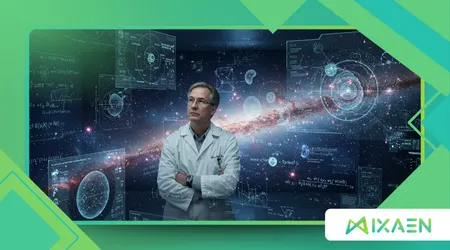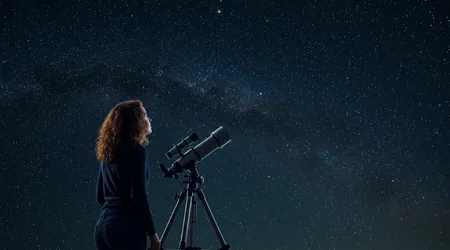Can We Ever Achieve a Theory of Everything?

The pursuit of a single, unifying equation that explains every fundamental force and particle in the universe is the Holy Grail of modern physics. This ambition to determine Can We Ever Achieve a Theory of Everything has driven thinkers from Einstein to Hawking.
Anúncios
It represents humanity’s deepest philosophical yearning: to find order and simplicity beneath the apparent chaos of reality. However, this cosmic detective story is currently stuck between two brilliant, yet mutually incompatible, masterpieces of science.
This detailed examination explores the monumental theoretical and experimental hurdles blocking our path to a true Theory of Everything (TOE).
We will analyze the core conflict between gravity and the quantum realm, dissect the leading contenders like String Theory and Loop Quantum Gravity, and finally confront the philosophical question of whether human knowledge itself is fundamentally limited. The answer isn’t just about physics; it’s about the limits of human cognition.
The Great Divorce: The Fundamental Incompatibility
The primary obstacle preventing us from answering Can We Ever Achieve a Theory of Everything is the deep, structural rift between the two pillars of 20th-century physics. These theories describe the universe perfectly in their own domains, yet they mathematically explode when combined.
General Relativity: The Fabric of Reality
Albert Einstein’s General Relativity (GR) beautifully describes the universe on the largest scales: planets, stars, galaxies, and the cosmos itself. It posits that gravity is not a force, but a curvature in the four-dimensional fabric of spacetime.
GR works flawlessly for smooth, continuous geometry. It is a classical, deterministic theory. However, when applied to extremely small scales or singularities (like a black hole’s center), its smooth math breaks down completely.
++ Mathematical Universe Hypothesis (Max Tegmark)
Quantum Field Theory: The Statistical Subatomic World
Conversely, Quantum Field Theory (QFT), encapsulated in the Standard Model, describes the universe on the smallest, most energetic scales: subatomic particles and three of the four fundamental forces (electromagnetism, strong nuclear, and weak nuclear).
QFT is a probabilistic, non-deterministic framework where energy comes in discrete packets (quanta). It models particles as excitations in quantum fields.
The Standard Model is incredibly precise, but it completely excludes gravity, treating it merely as an external background force.
The core tension is obvious: we cannot model the universe’s beginning (the Big Bang singularity) or black holes without fusing gravity and the quantum world.
Also read: How Philosophy Influences Modern Physics
The Problem of the Quantum Vacuum
The attempt to quantize gravity (to find the gravity particle, the “graviton”) leads to catastrophic mathematical results. When physicists try to integrate gravitons into QFT, the equations predict infinite values for energy and curvature at short distances.
This mathematical instability confirms that the current models are fundamentally incompatible, ensuring the question of Can We Ever Achieve a Theory of Everything remains unanswered. We are missing a core insight.

The Leading Contenders: Mapping the Theoretical Terrain
In the absence of experimental data, the race for a TOE is currently dominated by two highly ambitious, yet entirely different, theoretical frameworks. Each attempts to rewrite the rulebook on the nature of reality.
String Theory: A Symphony of Vibrations
String Theory (and its successor, M-Theory) suggests that fundamental particles are not point-like dots but incredibly tiny, vibrating, one-dimensional strings.
Different vibrational modes of these strings correspond to different particles, elegantly incorporating all known matter and forces, including the elusive graviton.
Read more: Exploring the Paradox of Free Will in a Determined Universe
The Dimensional Price
The theory’s greatest weakness is its requirement for extra spatial dimensions (typically ten or eleven dimensions). These dimensions must be “compactified” or curled up into spaces so small we cannot observe them.
This renders the theory largely untestable with current or near-future technology. The elegance comes at the high cost of experimental verification.
- Original Example: String Theory proposes a complex, multidimensional landscape of possible universes (the “Landscape”). While mathematically possible, this introduces a philosophical problem: if any fundamental constant is possible in some universe, then our universe’s specific constants might just be an accident, not a unique, explainable result of the TOE. This moves the question of Can We Ever Achieve a Theory of Everything from physics to philosophy.
Loop Quantum Gravity (LQG): Quantizing Spacetime Itself
Loop Quantum Gravity takes a more conservative approach, accepting the tenets of GR but applying quantum mechanics to spacetime itself, rather than trying to fit gravity into QFT. LQG proposes that space and time are not continuous but are made of discrete, indivisible packets, or “quanta of space.”
This approach avoids the infinities that plague String Theory. However, LQG has yet to fully demonstrate that General Relativity emerges smoothly from its quantized framework in macroscopic scales. Furthermore, it struggles to incorporate the Standard Model’s particle interactions as seamlessly as String Theory.
The Experimental Roadblock: Proving the Unprovable
The biggest challenge in resolving the theoretical conflict and determining Can We Ever Achieve a Theory of Everything is the sheer lack of empirical evidence for any theory that attempts to bridge the quantum-gravity gap.
Energy Scales and Technological Limits
To experimentally test String Theory or LQG, physicists need to probe the Planck Scale—the length and energy where quantum effects of gravity become dominant.
The Cosmic Barrier
The Planck Energy is GeV (Giga-electron Volts), a number utterly beyond human technological reach. The Large Hadron Collider (LHC), the most powerful particle accelerator ever built, operates at approximately
GeV. We would need a collider billions of times larger, perhaps encompassing the entire solar system, to reach the necessary energy levels.
This suggests that verification might require relying on indirect, naturally occurring events. Researchers are intensely analyzing cosmological data from the very early universe, black hole mergers, and neutrino oscillations, hoping to find minute “quantum gravity footprints.”
Analogy: Searching for the TOE is like trying to understand the inner workings of a Swiss watch (the universe) using only a flashlight and a rubber band. Our current tools (the LHC, telescopes) are insufficient to see the fine mechanism (the Planck scale).
We must wait for the universe itself to perform a rare, visible failure (like a unique black hole collapse) to provide the necessary glimpse.
The Philosophical Ceiling: The Limits of Human Knowledge
Beyond the physics, the question Can We Ever Achieve a Theory of Everything also touches on the nature of knowledge itself. Are there limits to what the human mind, operating within the universe, can comprehend about the whole system?
Gödel’s Incompleteness and The Closed System
Philosopher and physicist Frank Tipler famously discussed how Kurt Gödel’s Incompleteness Theorems might apply to physics. Gödel showed that any consistent formal system containing basic arithmetic must contain statements that are true but cannot be proven within that system.
If the universe’s governing laws constitute a formal mathematical system, then a TOE, to be complete, might necessarily have to include axioms or truths that are unprovable or un-derivable from the physical system itself.
This suggests that the knowledge required to derive the TOE might lie outside the observable physical universe, creating a philosophical paradox for the search for Can We Ever Achieve a Theory of Everything.
The Human Observer Bias
Our scientific method relies on observation and modeling. But our models are fundamentally constrained by our own cognitive structures and sensory limitations.
Consider the role of consciousness. If consciousness itself is a fundamental product of the universe, can a theory of the universe truly be complete without integrating consciousness?
Most physical TOEs ignore this problem. If consciousness influences the observed reality (as some interpretations of quantum mechanics suggest), then any “objective” TOE remains fundamentally incomplete.
Comparative Features of TOE Contenders
| Feature | General Relativity (GR) | Standard Model (QFT) | String Theory (M-Theory) | Loop Quantum Gravity (LQG) |
| Focus | Macroscopic (Gravity & Spacetime) | Microscopic (Electromagnetic, Strong, Weak Forces) | Unification of all forces via vibrating strings | Quantization of Spacetime itself |
| Nature of Time/Space | Continuous, Flexible Fabric | Continuous Background (Non-quantized) | Requires 10 or 11 dimensions | Discrete, Quantized “Loops” |
| Gravity Included? | Yes, defined as curvature | No, excluded from the model | Yes, naturally includes the graviton | Yes, inherently quantized |
| Testability (Current) | High (GPS, Black Holes) | High (LHC) | Virtually Zero (Requires Planck Energy) | Low (Indirect cosmological tests) |
Conclusion: The Enduring Journey
The question Can We Ever Achieve a Theory of Everything remains the most challenging and humbling endeavor in science.
The conflict between General Relativity and Quantum Field Theory is a deep schism that our current models String Theory and Loop Quantum Gravity can only tentatively bridge.
The immense energy required to test the Planck Scale forces us to rely on theoretical elegance and indirect cosmic observation rather than direct experiment.
The ultimate answer may lie not in a final equation, but in accepting that our understanding is perpetually asymptotic approaching, but perhaps never fully reaching, the truth.
The quest itself refines our understanding of reality, regardless of the final outcome. The unified theory may be unprovable or contain self-referential limits, but the pursuit continues to yield revolutionary insights, proving the value of the journey.
Frequently Asked Questions (FAQs)
Q: Why is gravity so much harder to integrate than the other forces?
A: Gravity is fundamentally different. The Standard Model forces are mediated by particles (like photons) in a fixed spacetime background.
Gravity, however, is the shape of spacetime itself. Trying to fit the quantum randomness of a force particle (the graviton) into the smooth, deterministic geometry of General Relativity causes the mathematical infinities.
Q: If String Theory can’t be tested, is it still science?
A: This is a major philosophical debate in physics. String Theory is currently considered a framework rather than a testable theory. Many argue that a theory which offers no falsifiable predictions does not meet the criteria of empirical science.
Its scientific merit rests on its potential for future, indirect verification and its mathematical elegance in attempting to answer Can We Ever Achieve a Theory of Everything.
Q: Did Stephen Hawking believe a Theory of Everything was possible?
A: Initially, yes, Hawking was optimistic. However, later in his career, he grew more skeptical, suggesting that perhaps a single, complete TOE might be unattainable, partly influenced by Gödel’s Incompleteness Theorems.
He argued that science would likely find an infinite series of increasingly refined theories, but perhaps never one final, ultimate truth.
